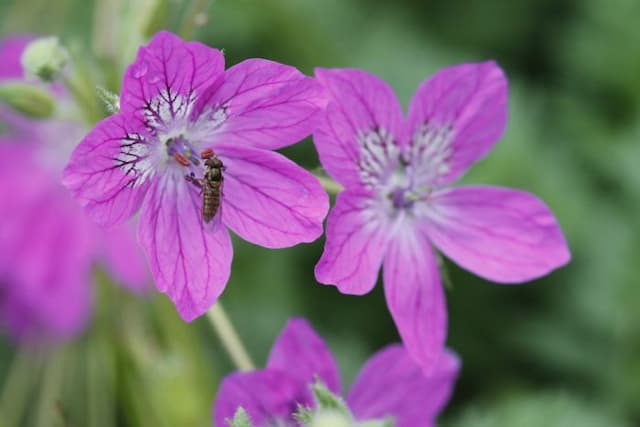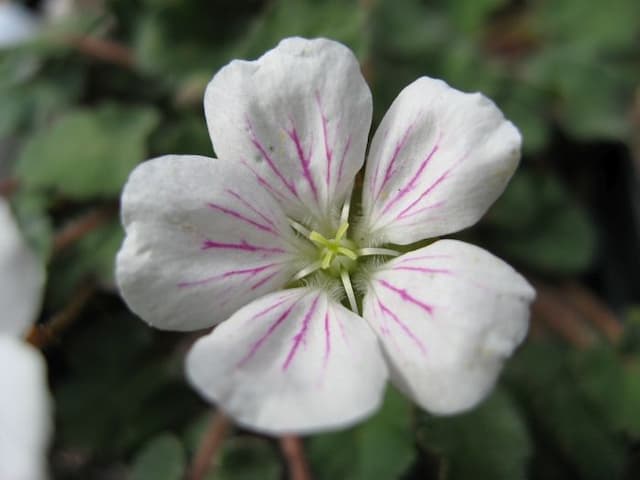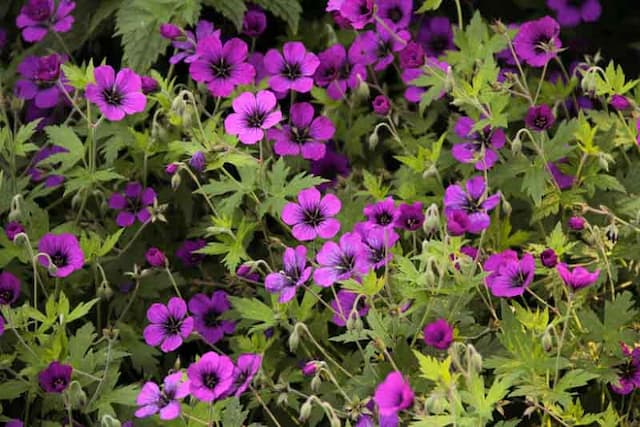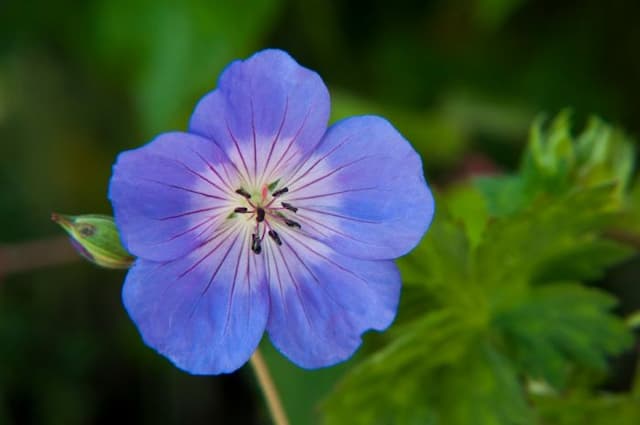Geranium Pelargonium 'Happy Thought' (Z/v)

ABOUT
Pelargonium 'Happy Thought' is a vibrant and decorative plant known for its attractive foliage and flowers. The leaves of the plant are a standout feature, being a rich green in color with a unique, bright yellow or cream-colored zone at the center, creating a stark contrast that catches the eye. This variegation gives the plant its name, suggesting a cheerful disposition. The flowers bloom in clusters on stems that rise above the foliage, adding to the plant's ornamental appeal. These blooms are often a vivid pink or a soft pink shade with darker markings on the petals, which serves to highlight the flower against the backdrop of the variegated leaves. The petals themselves are rounded, with a slightly ruffled appearance that gives the blossoms a full, lush look. The overall growth habit of Pelargonium 'Happy Thought' typically forms a bushy silhouette, which is well-suited for container gardening or as a standout addition to flower beds where its bright colors and distinct variegation can be fully appreciated. The combination of the cheerful variegated foliage and the showy floral display make Pelargonium 'Happy Thought' a popular choice for gardeners looking to add a pop of color and interest to their outdoor or indoor spaces.
About this plant
 Names
NamesFamily
Geraniaceae
Synonyms
Happy Thought Geranium, Zonal Geranium
Common names
Pelargonium 'Happy Thought'
 Toxicity
ToxicityTo humans
Geraniums are commonly recognized as non-toxic to humans. However, ingesting any part of the plant can still lead to minor symptoms in some individuals such as nausea, vomiting or diarrhea. It is always advisable to keep ornamental plants out of reach of children who might inadvertently consume plant material.
To pets
Geraniums can be mildly toxic to pets, particularly to cats and dogs. If ingested, they can cause symptoms such as vomiting, anorexia, depression, and dermatitis. In more severe cases, they may cause an allergic reaction. Pet owners should be cautious and keep these plants out of reach of their animals to prevent any potential health issues.
 Characteristics
CharacteristicsLife cycle
Perennials
Foliage type
Evergreen
Color of leaves
Variegated
Flower color
Red
Height
1-2 feet (30-60 cm)
Spread
1-2 feet (30-60 cm)
Plant type
Herb
Hardiness zones
10
Native area
South Africa
Benefits
 General Benefits
General Benefits- Decorative Appeal: Pelargonium 'Happy Thought' features striking foliage and vibrant flowers that add a splash of color and aesthetic interest to gardens and indoor spaces.
- Easy to Grow: This plant is known for being low-maintenance, making it suitable for novice gardeners or those with limited gardening experience.
- Adaptability: It can be grown in a variety of climates and conditions, both outdoors and indoors, given adequate lighting.
- Long Blooming: Pelargonium 'Happy Thought' typically has a long flowering period, providing a long-lasting display of blooms.
- Drought Tolerance: Once established, it has a degree of drought tolerance, requiring less frequent watering than many other plants.
- Pest Resistance: The plant has natural resistance to some common garden pests, thereby reducing the need for chemical treatments.
- Container Gardening: It thrives in pots and containers, making it a versatile choice for balconies, patios, and indoor spaces.
 Medical Properties
Medical PropertiesThis plant is not used for medical purposes.
 Air-purifying Qualities
Air-purifying QualitiesThis plant is not specifically known for air purifying qualities.
 Other Uses
Other Uses- Artistic Intents: Geranium leaves, such as those of Pelargonium 'Happy Thought', can be used to create botanical prints or to add texture and visual interest in pressed flower art.
- Fragrance Enhancement: The leaves of the geranium can be placed in drawers or closets to impart a subtle, fresh fragrance to linens and clothing.
- Cooking Ingredient: The scented leaves of the plant can be used to infuse sugars or to flavor desserts like sorbets and jellies with its lemony-rose scent, though this should only be done with non-toxic varieties.
- Garden Design: The variegated foliage and brightly colored flowers can be used to create attractive patterns when planted in knot gardens or as part of garden mosaics.
- Biodegradable Confetti: Dried geranium petals can be used as a natural, eco-friendly confetti alternative for celebrations or weddings.
- Plant Dye: The petals and leaves, especially from deeply pigmented varieties, can be used to naturally dye fabrics or paper.
- Mood Enhancer: Some people find the act of caring for and observing the growth of geraniums to be a form of stress relief and emotional well-being.
- Insect Deterrent: Geraniums are traditionally believed to help repel certain insects, so they may be planted near outdoor seating areas or windows.
- Soil Indicator: The health of geranium plants can sometimes be an indicator of soil conditions, helping gardeners identify soil that is too alkaline or deficient in certain nutrients.
- Teaching Tool: Geraniums can be used in educational settings to teach children about plant biology, the process of photosynthesis, and the basics of horticulture.
Interesting Facts
 Feng Shui
Feng ShuiThe Geranium is not used in Feng Shui practice.
 Zodiac Sign Compitability
Zodiac Sign CompitabilityThe Geranium is not used in astrology practice.
 Plant Symbolism
Plant Symbolism- Thoughtfulness and Reflection: The 'Happy Thought' in this geranium's name suggests a symbol of contemplation and inner reflection.
- Optimism: As its name implies, 'Happy Thought' geranium is often associated with positivity and good cheer.
- Balanced Emotions: Geraniums symbolize emotional balance and harmony, and 'Happy Thought' emphasizes a positive, balanced mindset.
 Water
WaterThe Geranium, commonly known as Pelargonium 'Happy Thought', should be watered thoroughly whenever the top inch of soil feels dry to the touch; this may be approximately once a week, but frequency can vary depending on environmental conditions. Always water at the base of the plant, avoiding the leaves to prevent fungal diseases. During the active growing season in spring and summer, ensure the plant receives about 12-16 ounces of water, while in winter, reduce watering to prevent waterlogging. Adjust the frequency based on temperature and humidity, as Geraniums prefer soil that is moist but not soggy.
 Light
LightGeraniums thrive in bright, indirect sunlight. A spot near a south or west-facing window that receives at least 4-6 hours of sunlight daily is ideal. Avoid placing the Pelargonium 'Happy Thought' in direct midday sun, which can scorch the leaves, and be mindful of low light conditions that can weaken the plant.
 Temperature
TemperatureGeraniums are happiest in temperatures between 65 to 75 degrees Fahrenheit, but they can tolerate a range down to 55 degrees and up to 80 degrees Fahrenheit. Protect the Pelargonium 'Happy Thought' from drafts and sudden temperature changes to maintain consistent growing conditions. This plant does not tolerate frost, so it should be brought indoors or protected when outside temperatures drop below 55 degrees Fahrenheit.
 Pruning
PruningPruning Geraniums promotes bushier growth and prevents them from becoming leggy. Trim back the Pelargonium 'Happy Thought' in late winter or early spring, cutting above a leaf node to encourage new growth. Deadhead spent flowers regularly to encourage continuous blooming. After pruning, a light application of fertilizer can help the plant recover and push out new foliage.
 Cleaning
CleaningAs needed
 Soil
SoilGeranium 'Happy Thought' thrives in well-draining soil enhanced with organic matter, like compost or peat moss. A potting mix designed for cacti can be appropriate, as it ensures good drainage. The ideal pH for this geranium should be slightly acidic to neutral, ranging from 6.0 to 7.0.
 Repotting
RepottingGeranium 'Happy Thought' should be repotted every two to three years or when it becomes root-bound. The best time to repot is in early spring before the growing season starts.
 Humidity & Misting
Humidity & MistingGeranium 'Happy Thought' prefers moderate humidity levels, but is quite adaptable and can tolerate the drier air found in most home environments. Avoid overly humid conditions which may promote fungal diseases.
 Suitable locations
Suitable locationsIndoor
Keep in bright, indirect light and away from drafts.
Outdoor
Plant in a sunny spot with some afternoon shade.
Hardiness zone
10-11 USDA
 Life cycle
Life cycleGeranium 'Happy Thought' begins its life as a seed, germinating in warm, moist soil within a few days to weeks. As a seedling, it develops true leaves and a root system before entering the vegetative growth stage where it rapidly increases in size and foliage. The plant then enters the flowering stage, producing distinctive blooms that may vary in color, generally throughout the warmer months. After pollination, it can produce seeds, completing the reproductive cycle. Following seed set, if conditions are not favorable, the plant may enter dormancy, conserving energy until favorable conditions return. Throughout its life, the Geranium 'Happy Thought' can be propagated vegetatively through cuttings, allowing gardeners to clone and spread the plant more effectively than by seed.
 Propogation
PropogationPropogation time
Spring-Early Summer
The Pelargonium 'Happy Thought', commonly known as a type of Geranium, is primarily propagated through stem cuttings. The best time to propagate these plants is during the late spring or early summer when the plant is actively growing. To propagate by cuttings, select a healthy stem with at least three leaf nodes and cut just below a node using a sharp, clean knife or scissors. The cut end of the stem should be allowed to callous over for a few hours or overnight to prevent rot. Afterward, dip the cut end into rooting hormone powder to encourage root growth and plant it in moist potting mix. Ensure the potting mix remains consistently moist but not soggy, and keep the cutting in a bright spot without direct sunlight. Roots typically develop within a few weeks after which the plant can be transferred to a larger pot.









